AMD Socket-AM2: Same Performance, Faster Memory, Lower Power
by Anand Lal Shimpi on May 23, 2006 12:14 PM EST- Posted in
- CPUs
Athlon 64 X2 5000+: A Cheap FX or Overpriced 4800+?
Although the FX-62 conclusion was pretty straight forward, the Athlon 64 X2 5000+ gives us another ambiguous candidate to evaluate. Clocked at 2.6GHz, the 5000+ gives you a nice clock speed advantage over previous X2s. However, with only a 512KB L2 cache there may be situations where the clock speed advantage over the Athlon 64 X2 4800+ is diminished.
3D Rendering - Cinebench 9.5
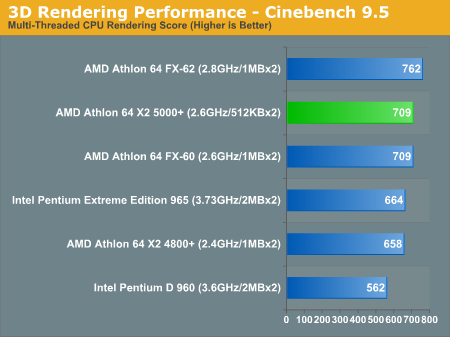
We've already seen that many of our 3D rendering and media encoding tests are cache-size independent when running on Athlon 64 X2/FX processors, thus it's no surprise that the X2 5000+ is able to offer identical performance to the FX-60 despite having half the L2 cache per core. The clock speed advantage over the X2 4800+ is also significant enough to offer a pretty decent performance advantage; in fact, in this light, the Athlon 64 X2 5000+ looks pretty impressive.
3D Rendering - 3dsmax 7
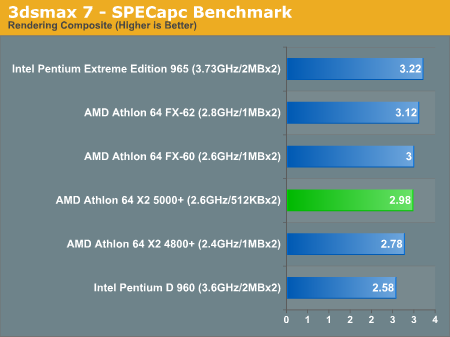
The story under 3dsmax 7 is pretty similar to what we saw under Cinebench; there is a slight performance penalty compared to the FX-60 thanks to a smaller L2 cache, but overall the performance of the X2 5000+ is quite respectable. As we saw in our FX-62 investigation from the previous page, the Extreme Edition 965 is very tough to beat in this test thanks to its high clock speed, very fast FSB and dual core + Hyper Threading combination.
Video Encoding - DivX 6.1.1 Pro

Once again, there's no performance difference between the X2 5000+ and the FX-60, bringing the 5000+ very close in performance to the FX-62 at a significantly lower cost. Thanks to the clock speed advantage, the 5000+ is also clearly faster than the X2 4800+.
Video Encoding - Windows Media Encoder 9
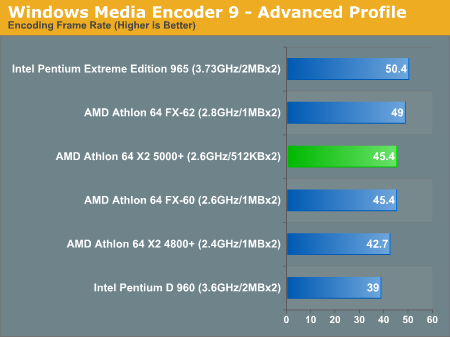
Windows Media Encoder 9 also has the X2 5000+ and FX-60 performing identically, and obviously outperforming the X2 4800+.
Video Encoding - Quicktime 7.0.4 (H.264)
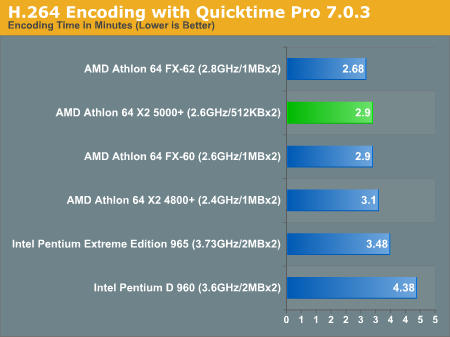
The video encoding trend continues with our Quicktime H.264 test, the 5000+ is second only to the FX-62.
MP3 Encoding - iTunes 6.0.1.4
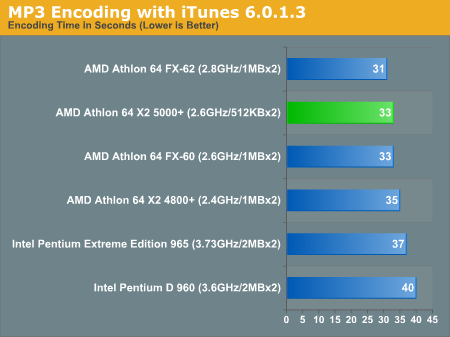
Our iTunes MP3 encoding test produces identical results to what we've already seen in previous benchmarks, the Athlon 64 X2 5000+ isn't really hampered by its 512KB L2 cache thus far.
Gaming - Quake 4
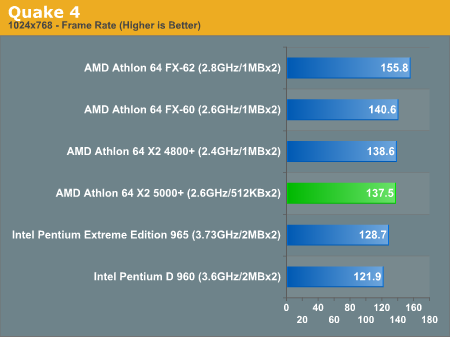
The tables do turn as we look at gaming performance however; not only does the Athlon 64 X2 5000+ lose to the FX-60, but it also loses to the lower clocked Athlon 64 X2 4800+. While the Athlon 64 X2 5000+ is wonderful in our application tests, it looks like there may be a very different verdict for gamers.
Gaming - F.E.A.R.

Under F.E.A.R. the FX-60 is faster than the X2 5000+ once again, but this time the best the X2 4800+ can manage is to tie the performance of the 5000+. Given the $51 price premium for the 5000+, we'd want something that was at least faster than the 4800+.
Gaming - Oblivion
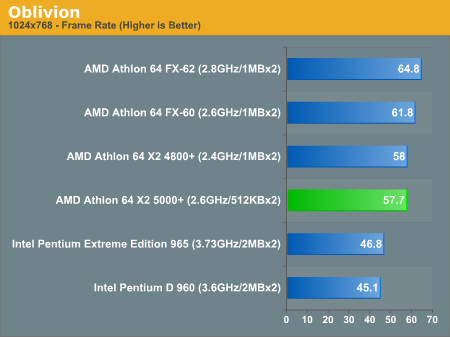
Finally in Oblivion we see that the X2 4800+ is ever so slightly faster than the 5000+, once again thanks to its larger L2 cache (despite a lower core clock speed).
The Athlon 64 X2 5000+ Conclusion
Once again we see the problem with AMD's model number system, where in some cases the 5000+ is no different than a FX-60 and in others it is only as fast if not slower than the cheaper X2 4800+. Our recommendation here would be to only opt for the 5000+ if you aren't a gamer, as it seems that 3D games are far more likely to appreciate a larger L2 cache than a higher clock speed with these chips.










83 Comments
View All Comments
darkdemyze - Tuesday, May 23, 2006 - link
z-ram isn't due for AMD procs for quite some time, I doubt this is their plan for June..mlittl3 - Tuesday, May 23, 2006 - link
Basically this is what I said above for my guess of the "trick" AMD will use. Anand said it will only affect some high-end users, read FX series so it can't be price cuts as some have suggested (that would effect everyone). Adding L3 cache is the only performance improvement I can think of that doesn't require changing the microarchitecture of the cores (well at least not a big change).However, TDP is still an issue here as someone above suggested. I don't know how much more power it takes to run L3 cache. Last time AMD did it was on K6 and power wasn't really measured back then.
By the way, please ignore Questar's comment below about z-ram being pig slow. I really don't think he knows what he is talking about. /shields eyes from incoming Questar flame
johnsonx - Wednesday, May 24, 2006 - link
K6-III did not have L3 cache. It had L2 cache, making the cache that all socket-7 boards had then an L3 cache.So, let's stop saying things like 'AMD hasn't done L3 cache since K6-III', etc.
mino - Wednesday, May 24, 2006 - link
Well, IMHO the point is AMD has used exclusive 3-level cache structure in the past so they have som experience with thi arrangement.Questar - Tuesday, May 23, 2006 - link
No flame here, look it up for yourself.Z-RAM has high capacitive loading, which results in slow speed.
At 4MB it'll run half the speed of SRAM.
Questar - Tuesday, May 23, 2006 - link
Large amounts of Z-RAM are pig slow.Ecmaster76 - Tuesday, May 23, 2006 - link
Seriously, the one area an Athlon X2 would be bandwidth starved and does it get tested in the preview? NOIn the review? NO
How long ago did we know that the K8 was not bandwidth limited in single application usage? YEARS
So yeah, DDR2 din't increase the 3dMark, big surprise
mlittl3 - Tuesday, May 23, 2006 - link
I think 3dMark06 is multithreaded now so all available cores and bandwidth should be used within the limits of the program. I could be wrong about this however.Ecmaster76 - Tuesday, May 23, 2006 - link
3Dmark06 is almost completely GPU limited. The 3Dmark CPU score did increase a bit, but I really was referring to graphics benchmarks in general.cscpianoman - Tuesday, May 23, 2006 - link
I was just noticing the performance differences between the FX and the EE. In some cases the FX tromps the EE by "gasp" 30%! In other cases the EE makes it's mark. This is part of the reason I am skeptic on Conroe. Yeah it's good. But I always take what Intel, or AMD for that matter, with a grain of salt. Just today we saw the 30% advantage translate down to about 15%. This seems just like any other generation change where 15% is to be expected. The current hype for the Conroe is a product of Intel's excellent marketing dept.